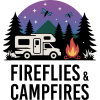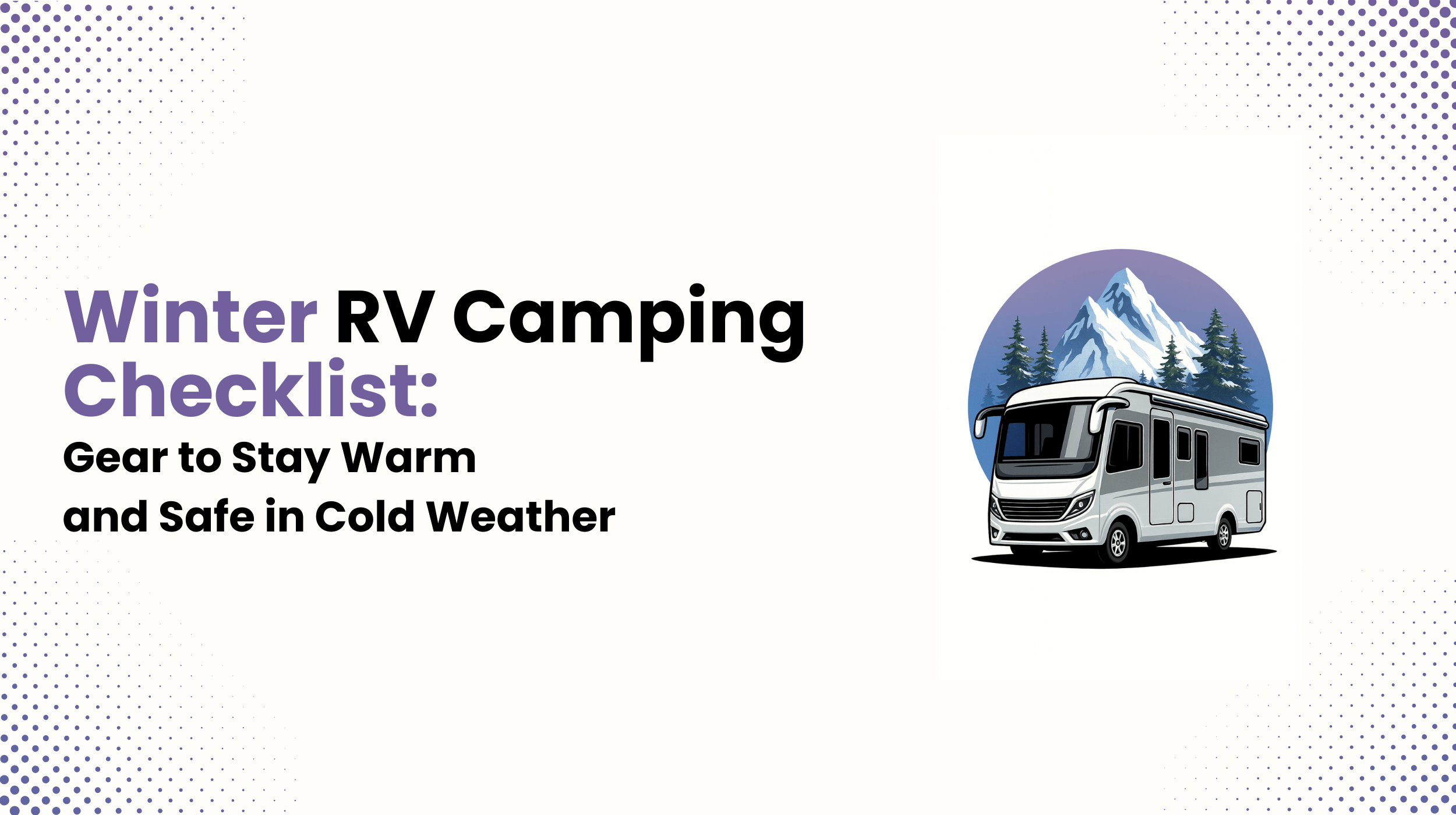TL;DR:
Winter RV camping offers snow-dusted landscapes, peaceful campgrounds, and a unique way to experience the outdoors. But it also brings challenges like frozen pipes, condensation, battery drain, and safety risks. This guide shares a complete winter RV camping checklist, along with practical tips on insulation, heating, clothing, food prep, pet safety, and mental wellness to help you camp warm, safe, and confident all season long.
Why Brave the Cold? The Magic of Winter RV Camping
Picture this: you wake up to a forest blanketed in snow, your RV warm inside as the morning light reflects off frosted pines. The campground is quiet, no crowds, no rush for hookups, just you and the winter landscape. That’s the beauty of winter RV camping, and in 2024, RVers took more than 25 million trips, and an increasing share are exploring year-round rather than just in summer. With fewer neighbors and unforgettable views and experiences, winter trips can be magical, but only if you’re prepared.
We wrote this post to deliver the ultimate checklist to keep you warm, safe, and stress-free while camping in cold weather. We’ll go beyond lame “pack a coat” advice and cover the real problems like frozen pipes, battery drain, condensation, and cabin fever, which are all very real things you’ll encounter.
Before You Pack: Core Principles for a Warm and Safe Trip
Before diving into gear, it’s important to understand the core challenges of winter RV camping. These aren’t just inconveniences; they will literally ruin your trip and in some cases, ruin your RV.
Cold temperatures stress your RV systems. Your pipes, tanks, and batteries are especially vulnerable since they are not inside the unit. Moisture is also your enemy. Without proper ventilation, condensation turns your cozy space into a damp mess.
When it gets cold, your power usage skyrockets. An increase in furnace usage, heated hoses, and dehumidifiers will drain your batteries faster than you can believe.
While you’re camping, safety is non-negotiable. Carbon monoxide, icy roads, and emergency access all require planning ahead, not the morning you wake up to sub-zero temperatures.
Keep these principles in mind as you build your gear list. At the end of the day, preparation is your best defense.
How Cold is Too Cold for an RV?
This is a common question that winter travelers have all the time: how cold is too cold to safely camp in an RV?
Most RVs can handle temperatures down to 20°F with proper prep and equipment. RVs with arctic packages (heated underbellies, double-pane windows) perform better in sub-freezing weather. This is what I have, and it makes it so much easier to camp when it’s cold.
At -20°F to -30°F, even upgraded rigs face risks. I’ve seen pipes freeze solid, batteries fail, and insulation struggle to keep the interior warm.
Don’t forget wind chill. Even if the thermometer reads 15°F, a strong wind can push your RV systems into dangerous territory.
The Battle Against Condensation: Managing Interior Moisture
Condensation is one of the top complaints among winter RVers. Windows drip, bedding feels damp, and mold risk increases (if you’re out for more than 3-4 days).
Why it happens: Every time you breathe, cook, or boil water, you add moisture to the air. When warm, moist air hits a cold surface (like a window), it condenses.
Solutions:
- Run a portable dehumidifier or moisture absorbers. This is something that I’ve never done before, but have heard it works so good.
- Crack a roof vent or window slightly, even in freezing temps, for airflow.
- Use a squeegee or towel on windows each morning.
- Avoid drying wet clothes inside your RV.
A small effort here saves you from a cold, clammy environment.
Power Management: Keeping the Lights (and Heat) On
Your furnace is both a lifesaver and a battery hog. Many boondockers learn this the hard way.
Challenges:
- Short winter days = less solar output (if you have solar).
- Furnaces and heated hoses drain batteries quickly.
- Cold weather slows battery chemistry, reducing capacity. This is by far one of the biggest issues.
Solutions:
- Carry a backup generator or portable power station.
- Choose campgrounds with electrical hookups when possible.
- Upgrade to lithium batteries for better cold-weather performance.
- Use propane wisely, supplement with an RV-safe electric space heater when you have hookups.
The Ultimate Winter RV Camping Checklist
Here’s the master list of must-have winter RV gear, organized by category.
Category 1: Essential RV Systems & Heating Gear
- RV Antifreeze – This is kind of a pain, but it will protect plumbing when dry camping.
- Heated Water Hose – Prevents frozen city water hookups.
- RV Skirting – Insulates underbelly; DIY foam board is cheap but bulky, commercial skirts are faster and neater.
- Insulated Window Covers & Thermal Curtains – Trap heat and cut drafts.
- Extra Propane Tanks – Winter trips burn through propane fast.
- RV-Friendly Space Heater – Look for tip-over shutoff and thermostat.
- All-Terrain or Snow Tires – Safe handling in icy conditions; carry tire chains for mountain passes.
- Smart Wi-Fi Temperature Sensors – Monitor tanks and bays remotely.
Category 2: Safety & Emergency Preparedness
- Carbon Monoxide & Smoke Detectors – Test batteries regularly.
- Fire Extinguisher – Accessible and not expired.
- Cold-Weather First Aid Kit – Include instant heat packs.
- Emergency Kit – Portable jump starter, weather radio, flashlights, emergency blankets.
- Snow Shovel & Ice Scraper – Essential for your site and slides.
- Solar-Powered Chargers – Reliable off-grid power backups.
Category 3: Cold-Weather Clothing & Bedding
- Layering System – Base (merino wool), Mid (fleece or down), Outer (waterproof shell).
- Footwear – Waterproof, insulated boots + camp booties.
- Bedding – Winter sleeping bags, electric blankets (if on shore power), plenty of extra blankets and comforters.
Category 4: Kitchen & Food Supplies
- Insulated Thermos/Mugs – Keep drinks hot.
- Slow Cooker/Instant Pot – Easy hot meals with minimal effort.
- Non-Perishable Food – Extra stock in case of storms, and you have to stay put for longer than anticipated.
- Insulated Water Bottles – Keep drinking water from freezing.
Category 5: Outdoor & Indoor Recreation (Nice To Haves)
- Outdoor Gear – Snowshoes, cross-country skis, sleds.
- Indoor Fun – Games, books, downloaded movies.
- Comfort Items – Cozy blankets, hot cocoa, marshmallows.
Category 6: Winter Care for Pets (If You Have A Furry Friend)
- Booties – Protect paws from salt and ice.
- Waterproof Jacket – Keeps pets warm and dry.
- Paw Balm – Prevents cracking.
- Insulated Pet Bed – Keeps them off the cold floor.
Your Winter Adventure Awaits
Winter RV camping isn’t just about surviving the cold; it’s about embracing and enjoying it. With the right preparation, you’ll enjoy quiet campgrounds, snowy landscapes, and cozy evenings by the fire. So pack smart, stay warm, and let winter become your favorite camping season.
Frequently Asked Questions
What equipment is most essential for cold weather RV camping?
A reliable heat source, insulation (skirting and window covers), a heated water hose, and safety gear like a CO detector are absolute must-haves.
How do you keep RV pipes from freezing in winter?
Use heated hoses, add RV antifreeze to tanks, skirt the RV, and keep the furnace running. In extreme cold, consider dry camping.
What are the best ways to heat an RV in winter?
Propane furnaces are standard. Supplement with electric heaters (if on hookups) and maximize insulation to retain heat.

